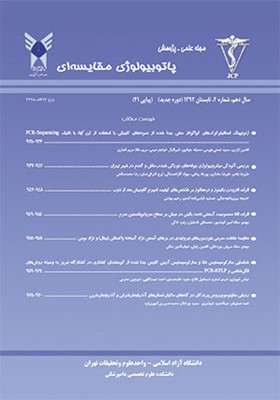طراحی کیت دات الایزا در جهت تشخیص آنتروتوکسین های (SEA) باکتری استافیلوکوکوس اورئوس و مقایسه آن با روش ساندویچ الایزا، تعیین صحت تشخیص آن در نمونه نانهای خامهایی
محورهای موضوعی : پاتوبیولوژی مقایسه ایسارا السادات بطحایی 1 , حامد اهری 2 , سید امیرعلی انوار 3
1 - .دانشکده صنایع غذایی واحد علوم و تحقیقات دانشگاه آزاد اسلامی تهران ایران
2 - دانشیار دانشکده علوم کشاورزی و صنایع غذایی دانشگاه آزاد اسلامی واحد علوم و تحقیقات تهران، ایران
3 - گروه علوم پایه و بهداشت دانشکده علوم تخصصی دامپزشکی دانشگاه آزاد اسلامی واحد علوم و تحقیقات تهران، ایران
کلید واژه: کیت دات الایزا, استافیلوکوکوس اورئوس, آنتروتوکسین,
چکیده مقاله :
در این مطالعه تشخیص و شناسایی آنتروتوکسین استافیلوکوکوس اورئوس به کمک طراحی کیت حساس Dot ELISA انجام شده است. در این مطالعه از کاغذهای نیتروسلولزی با منافذ 22/0 میکرون بهعنوان بستر استفاده شده است، بر روی بستر یاد شده آنتیبادی اختصاصی آنتروتوکسین استافیلوکوکوس اورئوس با رقت500/1 کوت گردیده و سپس توکسین اختصاصی به آنتیبادیهای چسبیده شده مجاورت داده شده است؛ در ادامه آنتیبادی نشاندار شده با آنزیم HRP با رقت 2000/1 اضافه گردیده، باگذشت زمان و شستشوی مجدد، سوبسترا اضافه شد؛ در این آزمایش نمونهها بهصورت دستی آلوده شده و سپس با روش ساندویچ الایزا به عنوان استاندارد طلایی مورد مقایسه قرار گرفت، این کیت قادر به تشخیص 50 نانوگرم بر میلیلیتر به بالا توکسین A بوده و چنانچه میزان توکسین کمتر از این مقدار باشد آن را بهصورت منفی گزارش کرده، در این آزمایش از 40 نمونه جمعآوریشده، 4 نمونه مثبت گزارششده، نشان میدهد که حدود 10 % نمونههای جمعآوریشده آلوده بوده است؛ امروزه با استفاده از کیت الایزا دات بهعنوان روش سریع با حساسیت و ویژگی نسبی، میتوان تکرارپذیری جهت تشخیص آنتروتوکسین A استافیلوکوکوس در نانهای خامهایی را بهبود بخشید.
In this study, detection and recognition of Staphylococcus aureus enterotoxin was performed by designing a Dot ELISA sensitive kit. In the present study, nitrocellulose membrane (NCM) with 0.22 micron pores was applied as the bed, and 1:500 diluted specific antibody of Staphylococcus aureus enterotoxin was coated on the NCM. Next, The HRP-tagged antibody was added with dilution of 1/2000, and the substrate was added gradually and rewashed. In this experiment, the samples were manually contaminated and then compared with the ELISA sandwich method as a gold standard. The kit is capable of detecting 50 ng/ml and higher of toxin A, and if the amount of toxin is less, it will report it negatively. In this test, of which 40 samples were collected and 4 positive cases were reported, it was revealed that about 10% of the collected samples were contaminated. Nowadays, using the Dot ELISA kit as a quick method with relative sensitivity and properties, it is possible to improve the repeatability of detecting Staphylococcus enterotoxin A in creamy candies.
_||_


